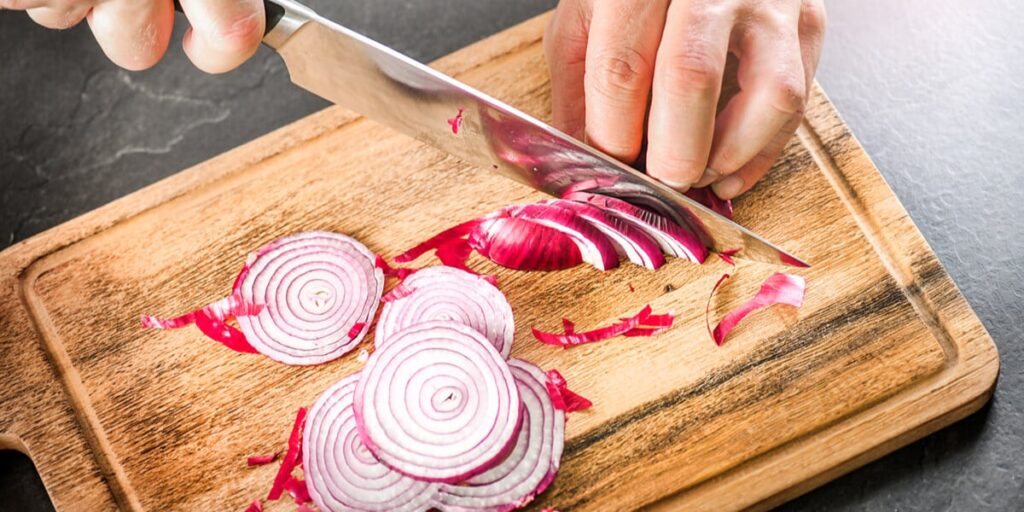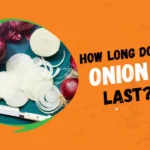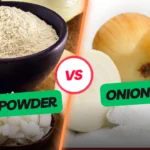Onions are a staple ingredient in countless recipes, adding flavor and depth to dishes worldwide. However, it’s common to find yourself with a partially used onion after preparing a meal. Knowing how to store a cut onion properly can help extend its shelf life and preserve its freshness, ensuring you can make the most of this versatile vegetable.
Here, we will explore how to store a cut onion, considering temperature, humidity, and container selection. By following these tips, you can minimize waste and enjoy the full potential of your onions for longer periods.
How Long Do Onions Last?
Depending on the storage circumstances, onions can last a variety of times. Ordinarily, whole onions may be kept in a cold, dry, and well-ventilated area for up to two months. After chopping, an onion must be refrigerated and utilized within a few days. For up to a week, chopped or sliced onions can be kept in the refrigerator in an airtight container. It is crucial to remember that these are only basic recommendations and that the freshness and quality of the onions may vary.
How To Store Peeled Or Cut Onions?

To keep onions fresh and stop them from rotting rapidly, they must be stored correctly after peeling or chopping. With their versatility in the kitchen, onions are common in many meals. Here are some suggestions on how to store peeled or sliced onions, whether you have leftover onions from a dish or want to prepare them ahead of time for convenience:
Refrigeration Method:
- Tightly wrap the peeled or chopped onions in aluminum foil or plastic wrap.
- Put the wrapped onions in an airtight container or a resealable plastic bag.
- To maintain track of freshness, write the date on the bag or container’s label.
- Keep the onions in the refrigerator’s crisper drawer, which offers a chilly and damp atmosphere.
- Onions can absorb flavors from nearby items, so keep them away from pungent dishes while keeping them.
- For optimum freshness, use the chilled onions within two to three days.
Freezing Method:
- Peel the onions and cut them into slices or any preferred shapes.
- To blanch onions, add them to boiling water for one to two minutes, then plunge them into an ice bath to halt the cooking.
- After the onions have been blanched, properly drain them and dry them with paper towels.
- Pack the dried onions in airtight containers or freezer-safe bags, pressing out as much air as possible before sealing.
- Write the date and portion size on the bags or containers if required.
- The frozen onions can stay fresh for up to 6 months if they are kept in the freezer.
- Add the required quantity of frozen onions to recipes without thawing them first.
Dehydration Method:
- Peel the onions and cut them into uniformly thin slices.
- Arrange the onion slices on a baking sheet or dehydrator tray that has been parchment paper-lined.
- Set the oven to the lowest setting or the dehydrator to a low temperature (about 130°F or 54°C).
- The drying process for onions typically takes 8 to 12 hours in a dehydrator or 3 to 4 hours in an oven to make them crispy and brittle.
- Before keeping, let the dehydrated onions reach room temperature.
- Put the dried onions in a glass jar or airtight container with a tight-fitting cover.
- The dehydrated onions should be kept out of direct sunlight in a cool, dry location.
- Onions properly dried out can survive for several months to a year.
How Long Do Onions Last In The Freezer?
Onions may be kept in the freezer for a long time, but their flavor and quality may suffer. Onions with appropriate storage may be kept in the freezer for up to a year. It’s crucial to be aware that onions might lose some firmness when frozen and become softer when thawed. Onions should be peeled, diced, and put in an airtight container or freezer bag before frozen. Before freezing, onions should be blanched to retain their flavor and texture. When onions are blanched, the cooking process is stopped by immediately removing them from the water and placing them in an ice bath. Properly frozen onions should be consumed within a year for the best flavor and quality.
How To Tell If An Onion Is Bad Or Spoiled?
There are a few indicators to watch out for in order to tell if an onion is rotten or spoiled. First, look for any mold or black patches on the onion’s skin since these are signs of deterioration. In addition, an onion is no longer fresh if it feels mushy or squishy to the touch. A powerful, unpleasant odor emanating from the onion is another sign that it has spoiled. Throwing away the onion if any of these symptoms are present is important to prevent potential health hazards.
Conclusion
In conclusion, it is crucial to carefully store a chopped onion to preserve its freshness and stop it from deteriorating. Before putting it in the refrigerator, store it in an airtight container or wrap it securely in plastic. Its flavor may also be preserved by keeping the sliced side down and away from meals with strong aromas. To ensure the best flavor and quality, onion should be consumed within a few days of being cut. These recommendations will help you keep a chopped onion functional for your culinary requirements while extending its shelf life.
FAQs
How Do You Store Half An Onion?
To store half an onion, wrap it tightly in plastic wrap or place it in an airtight container and refrigerate. Alternatively, you can also store it in a sealed plastic bag.
Do Onions Need To Be Refrigerated Once Cut?
No, onions do not need to be refrigerated once cut.
Do Onions Last Longer In The Fridge Or On The Counter?
Onions generally last longer when stored in a cool, dry, and well-ventilated place like the pantry or a countertop. Storing them in the fridge can cause them to become soft and moldy more quickly.
How Long Can You Store Onions?
Onions can be stored in a cool, dry, and well-ventilated place for several months.




![What is an Onion Julienne Cut - [Benefits, Tips and Methods] onion Julienne Cut](https://juicerhunter.com/wp-content/uploads/2023/09/onion-Julienne-Cut-juicer-hunter-150x150.webp)
![How to Chop an Onion [ Easy Steps and Tips ] How to Chop an Onion](https://juicerhunter.com/wp-content/uploads/2023/09/How-to-Chop-an-Onion-150x150.webp)
